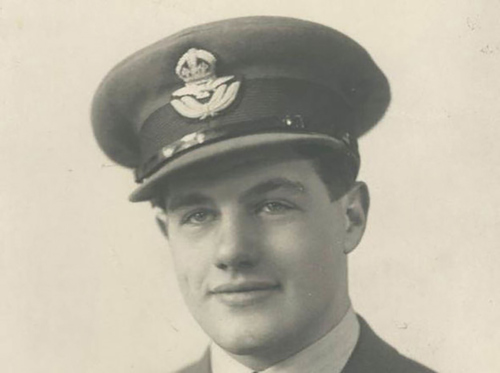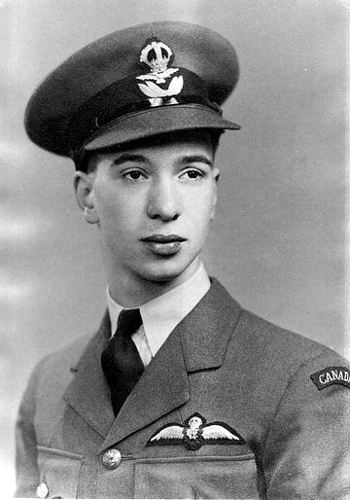11 March 2024
From For Evermore: Air Service casualties
We’ve scoured For Evermore, our online digital stories archive, to pick out some of our favourite Air Force tales.
Stories from For Evermore
The RAF & Commonwealth Air Forces in the World Wars

"The Last One" G. Smulders (© IWM Art.IWM ART 16653)
The Royal Air Force was established in 1918, after growing from the Royal Flying Corps and Royal Navy Air Service.
Commonwealth nations soon established their independent air forces following the First World War, including:
- Royal Australian Air Force
- Royal New Zealand Air Force
- Royal Indian Air Force
- Royal Canadian Air Force
- Royal South African Air Force
Airmen came from across the world to serve during the World Wars. In the case of the Second World War, pilots from conquered nations, such as Poland, France or Czechoslovakia, joined in droves as a way to fight on against the Nazi menace.
Some 300,000 personnel served in the Royal Air Force and the air services in the Great War. At the peak of the Second World War, over a million men and women served in the air forces around the world.
The Commonwealth War Graves Commission commemorates over 135,000 Air Force personnel of the World Wars. Not just pilots, these represent the myriad of roles within the air services, including Women’s Auxiliary Air Force members, mechanics, technicians, clerks, plotters and many other Air Force roles.
Read all the Air Force stories on For Evermore.
Flight Lieutenant Alastair Donald Mackintosh “Sandy” Gunn
 Alastair “Sandy” Gunn was born in Auchterarder, Perthshire on 27 September 1919, the son of surgeon James Turner and his wife Adelaide.
Alastair “Sandy” Gunn was born in Auchterarder, Perthshire on 27 September 1919, the son of surgeon James Turner and his wife Adelaide.
Sandy was educated at the Cargilfeld Prep School in Edinburgh and on leaving school took an engineering apprenticeship at the Harland and Wolff shipyard in Govan, Glasgow.
Engineering lay in Sandy’s future as, following his time at Harland and Wolff, he gained a place at Pembroke College, Cambridge to study mechanical sciences.
So did military service. On 22 February 1940, Sandy enlisted with the RAF, becoming an aircrew candidate in June of that year. He gained his wings and promotion to Sergeant in January 1941.
Sandy was first posted to 48 Squadron Coastal Command, flying photo reconnaissance missions. He was bounced around various RAF airfields in the UK including RAF Wick in the north of Scotland, flying Spitfires long-distance, high-altitude photo missions.
At RAF Wick, Sandy was tasked with missions photographing German positions and shipping in Norway and the North Atlantic. Such sorties were long, lonely, and dangerous. On one such mission, Sandy ran out of fuel and was forced to ditch in the sea, although he was shortly rescued and flying again.
On 5 March 1942, the recently promoted Flying Officer was on a mission over Trondheim, Norway, searching for the German battleship Tirpitz when he was ambushed by Luftwaffe fighters and shot down.
Sandy managed to bail out but suffered burns to his face and hands. His injuries halted his original plan of cross-country skiing to neutral Sweden.
After surrendering, his German captors kept Sandy for three weeks before being transferred to Stalag Luft III, the site of the famous Great Escape.
Sandy joined the escapees, working as a Security Officer, guarding the Escape Committee meetings and joining the tunnelling team.
On the night of 24 March 1944, Sandy and the 75 other POWs made their escape.
Unfortunately, Sandy was captured shortly after the breakout and turned over to the Gestapo. He was executed on 6 April 1944 along with 49 other escapees. Sandy was cremated and his remains were later interred at CWGC Old Garrison Cemetery, Poznan.
Flying Officer Lester Ferguson Blakeney
 Some 44% of Bomber Command crewmen were killed on operations over Europe. Born in Halifax, Nova Scotia, Flying Officer Lester Blakeney was one of them.
Some 44% of Bomber Command crewmen were killed on operations over Europe. Born in Halifax, Nova Scotia, Flying Officer Lester Blakeney was one of them.
Lester was one of the 6 crewmen who flew a Halifax bomber for No. 420 Squadron, Royal Canadian Air Force, on the night of February 25, 1944.
Their destination was Augsburg. The city was the site of many aircraft industry production plants, which were the target of an extensive Allied bombing campaign known as Operation Argument, aka Big Week.
While casualties at Augsburg were significantly lower than in previous mass bomber raids, the RAF still lost 20 aircraft or 3.4% of bombers sent over. Lester’s Halifax was one of those lost.
Only William Bourdat was able to bail out, but he had no idea what happened to their Aircraft. It was later revealed by German documents that the plane had crashed near the German village of Grossengstinen.
The loss of Lester seems to have robbed the Royal Canadian Air Force of a dedicated, diligent airman.
During training, Lester was described as “neat and methodical in habit, pleasant and cheerful in manner” and “should do quite well with further Service experience”.
Like many bomb crew members shot down in the Augsburg raid, Lester is buried at Durnbach War Cemetery.
Our thanks to Julene W for sharing Lester’s story. Don’t forget to upload yours on For Evermore.
Pilot Officer Ronald Arnold Hadley
 One of the joys of For Evermore is discovering the family connections between the casualties in our care and members of the public.
One of the joys of For Evermore is discovering the family connections between the casualties in our care and members of the public.
We were delighted that Julia Hadley shared the story of her grandfather Ronald Arnold Hadley.
Ronald “Ron” Hadley was born in Thames, New Zealand. Alongside his older brother Trevor, Ron enlisted in the Armed Forces at the outbreak of the Second
World War.
The brothers served with 58 Squadron, Bomber Command, based at Linton-on-Ouse, Yorkshire.
Tragically, Ron would lose his life on 9 September 1940 when his plane crashed with engine trouble. He was just 20 years old.
Member Barbara Ellen Goodwin
 It’s well known that women served with distinction in the Women’s Auxiliary Airforce in the Second World War, but did you know similar organisations existed in the First World War?
It’s well known that women served with distinction in the Women’s Auxiliary Airforce in the Second World War, but did you know similar organisations existed in the First World War?
The Women’s Royal Air Force was established on 1 April 1918. Originally set up to create a corps of female mechanics, the WRAF soon expanded to include several other non-combat roles, such as drivers, caterers, clerks, tailors, and other positions.
Amongst their number was Member Barbara Ellen Goodwin whose story was shared on For Evermore by regular contributor Sally McGlone.
Barbara, one of eight children, was born in 1894 in Stow Bedon, England.
Previously working as a barmaid, Barbara enlisted with the WRAF on 2 April 1918. Interestingly, on her application, Barbara stated she was only prepared to work if she could travel from King’s Lynn station.
She was assigned to the 7th Wing Headquarters in King’s Lynn and was employed as a mechanic in the repair shops of Narborough Aerodrome.
Narborough was the largest aerodrome in the country and the place of employment for many WRAF members. Barbara’s sister Mary joined up later in 1918 and worked alongside her at Narborough.
Despite being away from the slaughter of the Western Front, workers like Barbara were still vulnerable to sickness.
Sadly, this seems to be the case with Barbara. She contracted influenza on 4 November 1918, just a week shy of the Armistice.
Barbara was the only WRAF servicewoman at Narborough to die during the First World War. Her funeral was attended by many of her Narborough colleagues, with the WRAF members forming a guard of honour.
Barbara was just 24 years old when she passed away. She is buried at St Mary’s Churchyard in Great Massingham.
Share your stories today on For Evermore
For Evermore: Stories of the Fallen is our online resource for sharing the memories of the Commonwealth’s war dead.
It’s open to the public to share their family histories and the tales of the service people commemorated by Commonwealth War Graves so that we may preserve their legacies beyond just a name on a headstone or a memorial.
If you have a story to tell, we’d love to hear it! Head to For Evermore to upload and share it for all the world to see.




